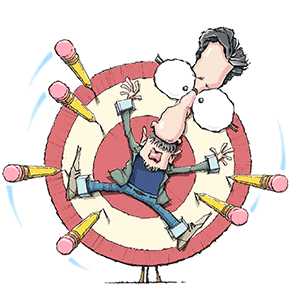Poor eyesight one of the toughest aspects of aging
Published in Senior Living Features
The moment usually occurs before your 50th birthday and signals that you've crossed a life Rubicon. Alas, body parts are aging.
For most of us, the body part first sending that message is our eyes.
A new survey by Bausch + Lomb -- they're a health care company best known for contact lenses and lens care products plus other ophthalmic pharmaceuticals -- says that 61 percent of people consider coping with poor eyesight one of the most difficult outcomes of aging.
That seems a no-brainer.
More interesting is their conclusion that poor eyesight is more difficult to deal with than poor hearing. And guess which capability they would save first?
So we asked Michael Pier, O.D., director of professional relations for North American Vision Care, part of Bausch + Lomb:
Q: What's the most common symptom of aging eye problems?
A: Blurry near vision. It's a natural phenomenon of the loss of focus power of the eye, a condition where the eye loses some flexibility. We may first notice it with a blurring of small details and things that are close to us.
Here's where those magnifiers sold in drug stores are an acceptable eyeglass option for many people. There's no reason to overmedicate if it's not necessary.
But if the problem is not fixed this way, it's time to see the doctor. Inability to see up close (presbyopia) may be one of the first signs your eyes are aging and this can be corrected with eyeglasses or contact lenses -- in particular multifocal contact lenses.
Q: Then you say the next concern is cloudy vision?
A: If your vision is cloudy, especially in one eye more than another, it is definitely time to see the doctor. It is most often an early sign of cataracts.
If you already have had cataract surgery, there is a membrane left in the eye that maybe can become cloudy in 18 to 20 percent of patients. It's an easy procedure to go in with a laser and clean it off.
Q: But you know that most people, particularly those old enough to be on Medicare, may not have health insurance to cover these ophthalmic visits
A: I agree with you, but this is no time for self-diagnosis. Go to the doctor right away. There are two common reasons for uncommon loss of peripheral vision – undiagnosed glaucoma or peripheral retina detachment. In both cases, don't dally with that.
Q: What about problems with nighttime vision?
A: When daylight savings time ends, it seems as if they suddenly took away the light and you may have bigger awareness of halos and glare. This is particularly caused by pupils opening to get more light in and not focusing all the light at one point on the retina.
Most people notice it more with the time change and, by January, they will be more used to it and it won't seem so extreme.
But there are ways a doctor can help. They have created a technique in eyeglasses called "high definition optics" and those lenses actually do decrease and almost eliminate halos and provide a better focal point for peripheral rays.
And, by the way, this nighttime problem can occur before age 40.
Q: What age group is the largest user of contact lenses, by the way?
A: The largest users of contact lenses are people 13 to 16 years old. The second-largest user group is 40 and older.
========
Contact the writer: Jane Glenn Haas: jghaas@cox.net (c)2011 The Orange County Register (Santa Ana, Calif.) Visit The Orange County Register (Santa Ana, Calif.) at www.ocregister.com
(c) The Orange County Register






Comments